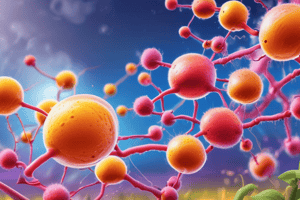Podcast
Questions and Answers
What is produced as a result of glycolysis?
What is produced as a result of glycolysis?
What occurs to pyruvate in the presence of oxygen?
What occurs to pyruvate in the presence of oxygen?
Which conditions lead to the inhibition of glycolysis?
Which conditions lead to the inhibition of glycolysis?
Which pathway is utilized to oxidize NADH in the absence of oxygen?
Which pathway is utilized to oxidize NADH in the absence of oxygen?
Signup and view all the answers
Which of the following produces more ATP in anaerobic pathways compared to lactate?
Which of the following produces more ATP in anaerobic pathways compared to lactate?
Signup and view all the answers
Study Notes
Glucose Breakdown (Glycolysis)
- Glycolysis breaks down glucose, producing reducing equivalents and releasing energy.
- The reaction: Glucose + 2 ADP + 2 NAD+ → 2ATP + 2 pyruvate + 2 NADH + 2 H+
- Occurs in the cytoplasm.
- An anaerobic process.
- Creates intermediates used to synthesize various molecules like carbohydrates, nucleic acids, amino acids, or fatty acids.
- Pyruvate, the end product, can be further broken down in subsequent catabolic processes.
Oxidation of Pyruvate in the Presence of Oxygen
- Glycolysis converts carbohydrates into pyruvate in the cytoplasm.
- Lactate and certain amines can also be converted to pyruvate.
- Pyruvate enters the mitochondria.
- Pyruvate Dehydrogenase (PDH) oxidizes pyruvate to form acetyl-CoA and NADH.
Oxidation of NADH in the Presence of Oxygen
- Glycolysis needs NAD+ to continue, requiring NADH to be oxidized.
- Two redox shuttles facilitate the transfer of reducing equivalents between cytoplasm and mitochondria: the α-glycerophosphate shuttle and the malate-aspartate shuttle.
Oxidation of NADH in the Absence of Oxygen
- Without oxygen, mitochondria cannot readily process NADH.
- NADH oxidation occurs in the cytoplasm.
- A buildup of cytoplasmic NADH lowers NAD+ levels, inhibiting glycolysis.
- Pyruvate is converted to lactate by the enzyme lactate dehydrogenase (LDH): Pyruvate + NADH + H+ ←→ lactate + NAD+.
- This reaction is reversible.
Anaerobic Pathways in the Absence of Oxygen
- Other anaerobic pathways produce less toxic end products and more ATP than lactate fermentation (which produces 2 ATP).
- Examples include succinate (4 ATP) and propionate (6 ATP) pathways.
- These are more common in invertebrates.
Studying That Suits You
Use AI to generate personalized quizzes and flashcards to suit your learning preferences.
Description
This quiz covers the biochemical processes of glycolysis and the oxidation of pyruvate. You'll learn how glucose is broken down for energy and the significance of pyruvate in cellular respiration. Explore the conversion of NADH and its role in these essential metabolic pathways.




